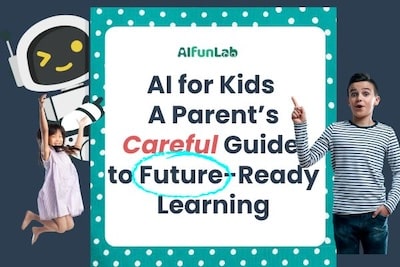Artificial Intelligence (AI) has gone from futuristic buzzword to classroom reality. By 2025, students are using AI tools to write essays, get instant math feedback, and chat with AI tutors late into the night. But is that a good thing?
New research from Stanford’s Human-Centered AI Initiative, UNESCO, and the Brookings Institution confirms what many parents already suspect:
AI can supercharge learning—but also carries real risks if not used thoughtfully.
If you're raising a child in a high-performance environment—Chinese, Korean, Indian, Jewish, or just deeply academic—you may be asking:
- Should my child use ChatGPT for homework?
- Is it still “learning” if AI explains it?
- Will AI help my child get ahead—or make school feel meaningless?
This guide breaks down the real pros and cons of AI in education—and what parents need to know before trusting the next chatbot or tutor app.
1. What Experts Are Saying
Stanford HAI (Human-Centered Artificial Intelligence)
Report: Artificial Intelligence and the Future of Teaching and Learning
- AI can enhance personalization and increase access to tutoring
- Concerns include widening equity gaps and reduced teacher-student connection
- Quote: “AI should augment—not replace—educators.”
Link: Stanford HAI Report Summary
UNESCO Global AI in Education Monitoring (2023)
- Highlights AI’s potential in low-resource education systems
- Warns of risks: over-standardization, data misuse, and underdeveloped emotional learning
Link: UNESCO AI in Education Portal
Brookings Institution Report (2023)
- AI can help close gaps in math and reading when used by trained educators
- Cautions against over-dependence and weak ethical oversight
Link: Brookings AI Report
2. The Pros of AI in Education
Personalized Learning
AI adjusts lessons to match a child’s pace and style, reinforcing strengths and addressing gaps.
Instant Feedback
Students receive real-time explanations and corrections, speeding up comprehension.
Accessibility for All Learners
Tools like text-to-speech, speech recognition, and interactive visuals help students with dyslexia, ADHD, and other learning needs.
24/7 Learning Resources
Apps provide unlimited access to lessons, quizzes, and videos—even for late-night homework or review.
Support for Teachers
AI can automate grading and admin work, freeing teachers to focus on engaging with students.
3. The Cons of AI in Education
Over-Reliance on Technology
Too much AI can weaken independent thinking and reduce students’ ability to solve problems on their own.
Privacy Concerns
Many platforms collect and process student data, raising questions about surveillance and digital security.
Unequal Access
High-quality AI tools often require modern devices or subscriptions, increasing the digital divide.
Built-in Bias
Algorithms can reinforce social and racial biases if not carefully designed and tested.
Reduced Human Connection
Overuse of screens and automated instruction may diminish meaningful teacher-student relationships.
4. Supporting Students With Learning Differences
AI tools can significantly assist students with special needs:
- Speech recognition software converts spoken words into text for students with speech challenges.
- Predictive text tools help students with writing difficulties.
- Gamified learning platforms engage students with attention disorders through interactive tasks.
5. Free AI Homework Helpers
- Khan Academy’s AI Tutor
Offers guided help and practice in subjects like math, reading, and science. - Socratic by Google
Lets students take a picture of a question and get step-by-step help with explanations. - Quizlet’s AI-Powered Flashcards
Automatically generates quizzes and study materials based on each student’s learning path.
6. How AI Enhances STEM Learning
- Virtual Labs
Simulate experiments so students can explore science safely and affordably. - Coding Platforms
Use AI to teach programming logic and syntax with immediate feedback. - Robotics Kits
Help students understand the connection between code and physical movement, encouraging hands-on learning.
7. Balancing AI With Traditional Learning
AI is a powerful tool—but not a replacement for real-world experiences. Healthy learning includes:
- In-person interaction with teachers and peers
- Physical activities to support mental health
- Family discussions to reinforce ethics, values, and curiosity
8. Real Success Stories: AI Helping Young Learners
- A study involving nearly 20,000 Australian students over 10 weeks showed a 47% improvement in final responses when AI was used effectively.
- Other studies report increased GPA and reduced study time when students use AI tools alongside high-quality teaching.
These examples show that AI can be an asset—when used intentionally.
9. What Experts Say About the Future
Mark Zuckerberg, CEO of Meta, said:
“We're going to live in a world where there are more AI agents than people.”
That may be true—but it underscores the need for human guidance. The American Psychological Association emphasizes that AI should support learning, not replace the emotional mentorship and support teachers provide.
10. Ethics, Integrity, and Development
As AI becomes more common in classrooms, parents should be aware of key challenges:
- Academic integrity: After ChatGPT’s release, 90% of college students reported using it for assignments
- Data privacy: Ask schools how student data is stored, shared, and protected
- Developmental risks: Overuse may weaken kids’ curiosity, grit, and problem-solving over time
Final Thought: AI Is a Tool—But Parents Must Lead
Here's what we now know:
AI can personalize learning, support special needs, and expand access.
But it can also displace real conversations, introduce bias, and tempt shortcuts.
As UNESCO reminds us:
“AI must support—not replace—human relationships in learning.”
No chatbot or algorithm can take the place of:
- A teacher’s encouragement
- A parent’s ongoing attention
- The real-world growth that comes from effort, empathy, and play
✅ Try This: Our 3-Day Family AI Awareness Challenge
- 📘 Day 1: Ask your child what they know about AI
- 💡 Day 2: Use an AI homework helper together—and talk about what it did well or poorly
- 🧠 Day 3: Create a "tech values" list as a family: What matters more than speed?
🎯 Your role isn’t to master AI. It’s to guide how your child grows with it.
With a background in trading, I’ve been fascinated by how many ppl in 20s and 30s manage real investment portfolios — often with surprising success. It’s a powerful reminder of how much can be self-taught when curiosity meets real-world feedback. My experience, including my time at UC Berkeley, and as a father of one kid in elementary school, drives my work at AIFunLab.io, where we build tools that motivate young children take charge of their own learning journeys.



.svg)





















